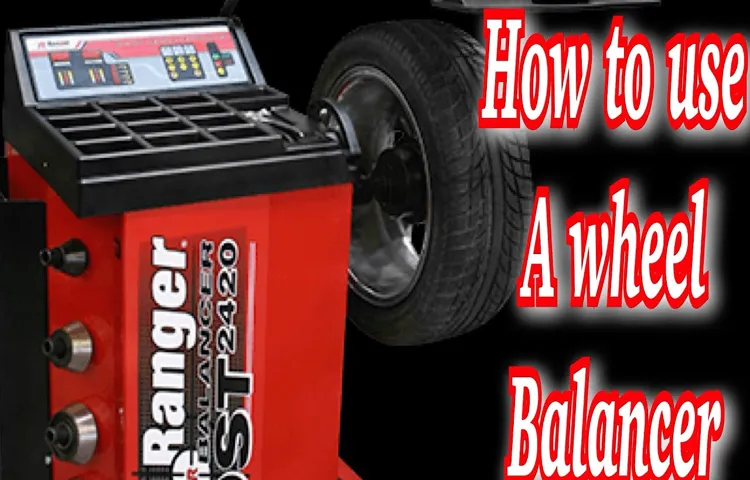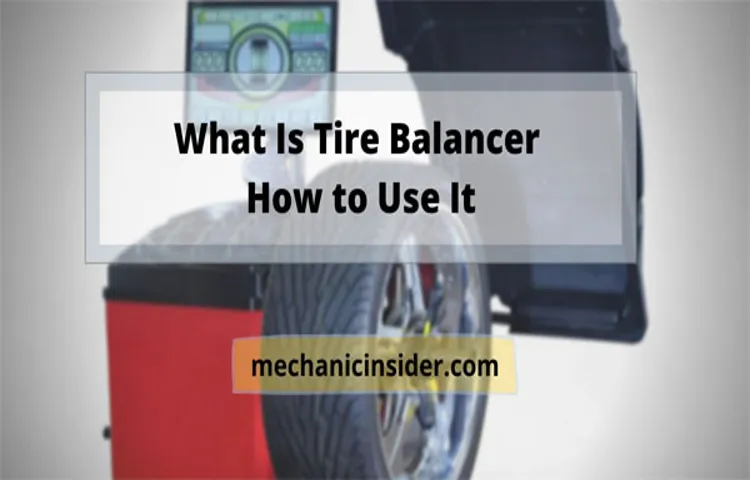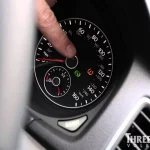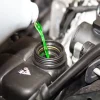Tire balancing is a crucial process to ensure safety and smooth driving. However, it can be challenging to perform the job efficiently, especially for those who are unfamiliar with the process. But, don’t worry! With a step-by-step guide, using a tire balancer is easier than you think.
In this blog, we’ll take a closer look at the steps needed to balance your tires successfully. From setting up the machine to testing the balance, we’ve got it all covered! So, if you’re ready to learn about tire balancing and how to use a tire balancer, let’s get started!
Table of Contents
Preparation
If you’re wondering how to use a tire balancer, the first step is to prepare your tires. Make sure they are clean and free of debris. Use a tire pressure gauge to check the tire pressure, and adjust it as necessary to ensure all tires are at the manufacturer’s recommended pressure.
It’s also important to check the tires’ tread depth and ensure they are not excessively worn. Once your tires are prepped, it’s time to set up the tire balancing machine. Make sure the machine is level and stable, and that the shaft and cones are properly installed and tightened.
Next, position the tire onto the machine and use the machine’s locking arms to hold it securely in place. Finally, input the necessary information into the machine, including tire size and weight, and let the machine do its job. Using a tire balancer takes a bit of preparation, but getting it right is essential for a smooth and safe ride.
Gather Required Tools and Equipment
When it comes to any project, preparation is key. Gathering the required tools and equipment is necessary to ensure the task at hand can be completed successfully. Depending on the project, the tools needed may vary.
It’s essential to research and create a list of all the necessary items before beginning. This way, you won’t encounter any surprises halfway through. Once you have created your list, you can then begin to gather the tools and equipment.
It’s a good idea to check that everything is working and in good condition before starting. This will save you time and frustration later on. Remember that having the proper tools and equipment can make any task easier and more achievable.
So take the time to gather everything you need before beginning, and your project will be off to a great start!

Inspect Tires for Damage and Debris
When preparing for a drive, inspecting your tires for damage and debris is a crucial step to ensure safety on the road. Start by checking for any punctures, cuts, or cracks on the tire surface. These damages can weaken the tire, making it prone to a blowout while driving.
Also, check the tire walls for any bulges or blisters. These are indicators of damage from impact with objects on the road. Don’t forget to clear any debris stuck in the tire tread that could cause loss of friction and reduce grip.
Items such as rocks, glass, and nails could penetrate the tire and cause a puncture. Therefore, make sure to remove any foreign objects from the tire before embarking on your journey. Neglecting to inspect your tires could lead to significant damage or even fatal accidents.
Therefore, take the time to check your tires’ condition regularly to ensure your safety and the safety of other road users.
Clean Tires and Wheels Thoroughly
Before starting to clean your tires and wheels, it’s important to prepare them thoroughly. Begin by removing any debris or loose dirt using a high-pressure water spray or a stiff-bristled brush. This will prevent any dirt from getting stuck to the wheels and tires during the cleaning process, and will make the cleaning process easier.
It’s also important to check for any small stones or pebbles that may be lodged in the treads of your tires, as these can cause damage to both your tires and the cleaning tools you use. Once you’ve gotten rid of any loose dirt and debris, it’s time to move on to the cleaning process itself. Remember to use a cleaning product that’s specifically designed for wheels and tires, as these are formulated to remove the most stubborn dirt and grime while still being gentle on your tires.
By properly preparing your tires and wheels before cleaning, you can ensure that the cleaning process is both effective and safe for your vehicle.
Mount the Wheel and Tire
If you’ve ever found yourself wondering how to use a tire balancer, look no further. Once you’ve gathered all the necessary tools, you can start mounting the wheel and tire. Begin by placing the wheel on the balancer, ensuring it is level and centered.
Next, attach the cone to the center hole of the wheel and secure it tightly. Then, place the dial indicator on the appropriate spot on the face of the wheel to measure its runout. Adjust the weights to achieve balance, taking care not to overcorrect and cause the wheel to become unbalanced in the opposite direction.
Once you’re satisfied with the balance, remove the wheel from the balancer and remount it on the vehicle. Regularly using a tire balancer can help prolong the life of your tires and improve your overall driving experience.
Attach the Wheel to the Balancer
After ensuring the wheel and tire is clean and free from any debris, it’s time to attach it to the balancer. Start by gently placing the wheel on to the balancer’s spindle. Ensure that you position it correctly, so that it is centered on the spindle.
Once centered, you can then slide the cone onto the spindle and adjust it to fit securely onto the center hole of the wheel. Carefully tighten the cone, but take care not to overtighten it, as this can damage the wheel. You can then use the balancer’s locking mechanism to ensure the wheel is securely fixed onto the spindle while it is balanced.
With the wheel and tire fixed in place, you can then start the balancing process and make any necessary adjustments to ensure optimal performance. By taking the time to properly mount your wheel and tire on the balancer, you can ensure that your vehicle’s tires will run smoothly and evenly, providing a comfortable and safe driving experience.
Center the Wheel on the Balancer
When it comes to mounting a wheel and tire on a balancer, one of the most important steps is centering the wheel on the machine. This ensures that the weight distribution is even and the tire will spin smoothly. To do this, start by placing the wheel and tire assembly onto the balancer.
Next, use the mounting cones to hold the wheel securely in place. Adjust the cones until they fit snugly against the wheel hub. Then, use the machine’s centering mechanism to align the wheel properly.
This may involve adjusting the height, width, or angle of the cones until the wheel is perfectly centered. Once the wheel is in the correct position, lock the cones into place and proceed with the balancing process. By taking the time to properly center the wheel on the balancer, you can ensure that your tires will perform at their best and last longer.
Secure the Wheel in Place
Mounting the wheel and tire is a crucial step in securing your vehicle. Before anything else, make sure that the wheel matches the size and pattern of the hub. Also, ensure that the lug nuts or bolts are compatible with your vehicle’s lug nut or bolt holes.
To mount the wheel and tire, lift the tire onto the hub and align the holes of the wheel with the studs or bolts. Then, gently push the wheel onto the hub and tighten the lug nuts or bolts using a wrench. Tighten them in a star pattern to ensure that they are evenly distributed.
Lastly, torque the lug nuts or bolts to the manufacturer’s specifications. A properly mounted wheel and tire provide stability and balance, and it reduces the risk of accidents or mishaps on the road.
Balancing the Tire
Tire balancing is a crucial process in maintaining the performance and lifespan of your vehicle’s tires. A tire balancer is a machine that ensures that your tires are balanced, meaning it evenly distributes the weight around the tire. This helps to prevent uneven wear on your tires, which can result in tire damage and poor performance.
To use a tire balancer, you need to start by removing the tire from your car. Then you’ll mount the tire onto the machine using a tapered cone. The machine will then spin the tire at a high speed, and sensors will detect any areas of the tire that are heavier or lighter.
The machine will then add or remove weights to balance the tire until it is evenly weighted. Finally, you’ll mount the tire back onto your car, and you’re good to go. By using a tire balancer, you can ensure that your tires are in top condition, reducing the risk of accidents and prolonging the life of your tires.
Enter the Tire Parameters into the Balancer
When it comes to balancing a tire, the first step is entering the tire parameters into the balancer. This is crucial because it allows the balancer to calculate the weight and location of any imbalances in the tire. The parameters include the wheel diameter, tire width, and the distance from the wheel edge to the tire tread.
Once you have gathered this information, you can input it into the balancer. The machine will then analyze the tire and determine where weights need to be placed to counteract any imbalances. By correcting these imbalances, you will reduce vibrations and increase the smoothness of your ride.
Remember, it’s important to balance your tires regularly to ensure optimal performance and safety on the road.
Start the Balancing Process
Balancing the tire is a crucial process that ensures your vehicle runs smoothly without causing any discomfort while driving. To begin the balancing process, you need to identify which tire requires balancing. Most times, a tire may require balancing when it starts to vibrate or pull to one side while driving.
Once the tire is identified, it is recommended that you take your vehicle to a professional mechanic who will use specialized tools to balance the tire correctly. Your mechanic will start by fitting small weights to the tire at specific points, constantly testing the smoothness of the ride, and making adjustments until the tire is evenly balanced. Properly balanced tires can improve fuel efficiency, prolong the lifespan of your tires, and make your driving experience more comfortable.
Don’t ignore the signs of an unbalanced tire and always prioritize the balancing process for a smoother, safer ride on the road.
Make Adjustments as Directed by the Balancer
When balancing a tire, it is important to make adjustments as directed by the balancer. Balancing a tire is crucial to ensure that it rotates evenly and doesn’t cause any vibrations. The balancer works by attaching weights to the rim of the tire to counterbalance any heavy spots.
If the balancer indicates that adjustments need to be made, it is important to follow those instructions to ensure that the tire is properly balanced. While it may take a little extra time, it is worth it in the long run to prevent uneven tire wear and potential safety issues on the road. By following the balancer’s directions and taking the time to properly balance your tires, you can enjoy a smooth and safe ride every time you hit the road.
Finishing Up
Now that you have learned how to use a tire balancer, it is important to finish up your balancing process correctly. First, double-check that all weights have been securely attached to the designated areas on the wheel and that there are no loose components that could cause imbalance on the tire. Next, take the balanced tire and slowly mount it onto the vehicle, making sure that it is securely fastened onto the hub and torqued to the recommended level.
Finally, take the time to test-drive your vehicle to ensure that the wheels are functioning smoothly. Remember that proper tire balancing not only ensures better handling and performance but also extends the life of your tires. So, go ahead and enjoy a smoother and safer ride with your newly balanced tires!
Remove the Wheel from the Balancer
When you’re done with balancing your wheel, it’s time to remove it from the balancer and get back to the road. This step is crucial to make sure that you don’t damage your newly balanced wheel. You will need to loosen the wing nut until you can slide the cone and spacer off the shaft.
Then, using the wheel lift or your hands, carefully lift the wheel off the balancer and make sure not to let it drop. Once you’ve removed the wheel from the balancer, you can then proceed to mount it back onto your vehicle and enjoy a smoother ride. It’s essential to take your time with this step, release the wing nut slowly and steadily while keeping a steady grip on the wheel to avoid any accidents.
With a little practice and focus, you’ll be a pro at balancing your wheels in no time!
Inspect the Wheel for Proper Balance
After checking the tire pressure and alignment, the final step in inspecting your wheels is ensuring they are properly balanced. A balanced wheel is important for a smooth and comfortable ride, as well as improved handling and safety. To check for balance, you can either use a wheel balancer or take your vehicle to a professional mechanic.
The mechanic will mount the wheel on a balancing machine and spin it to determine if any adjustments need to be made. If the wheel is not balanced properly, weights can be added or removed to even out the weight distribution. Remember, unbalanced wheels can cause excessive tire wear, vibration, and even damage to suspension components.
Be sure to always check for proper balance during routine maintenance to ensure a safe and enjoyable ride.
Reinstall the Wheel on the Vehicle
After replacing or repairing a tire, it’s important to reinstall the wheel back onto the vehicle correctly. Make sure the wheel is lined up correctly with the studs and slide it carefully into place. Then hand tighten the lug nuts to ensure the wheel is secured.
Once all the lug nuts are hand tightened, use a torque wrench to finish tightening to the manufacturer’s recommended torque specifications. This ensures the correct amount of pressure is applied to each lug nut to prevent the wheel from becoming loose while driving. Finally, double check that all lug nuts are tightened correctly to avoid any safety issues when driving.
By following these steps, you can safely and efficiently reinstall the wheel on your vehicle.
Maintenance Tips
If you own a tire balancer, then you understand how important it is to maintain it! Proper maintenance will not only extend the lifespan of your equipment but also ensure that it functions correctly each time you use it. The first step is to clean the machine regularly, removing any dirt or debris that may have accumulated on the rollers and bearings. Additionally, lubricating the machine will ensure that all moving parts remain functioning smoothly.
When using your tire balancer, it’s important to ensure that you’re using it correctly and following the manufacturer’s instructions carefully. For instance, it’s crucial to ensure that the tires are properly balanced, and the air pressure should be at the correct level. By taking these steps, you’ll keep your tire balancer functioning as it should, and you can enjoy its benefits for years to come!
Regularly Clean and Inspect the Balancer
Regularly cleaning and inspecting the balancer of your machinery is a crucial aspect of maintenance. Keeping the balance components of any type of machine, from engines to industrial fans, free from dirt and debris can extend the life of the machinery. Dirt and grime buildup can affect the balance of the components and reduce their efficiency.
Check the balancer frequently for any signs of wear and tear, cracks, or other damage. Balancers can become misaligned due to the harsh conditions they operate in, which can lead to increased wear and tear, and ultimately, machinery failures. By keeping your balancer mechanism clean and conducting regular inspections, you can increase the longevity of your equipment and improve overall performance.
Remember, a clean and well-maintained balancer equals a more efficient and reliable machine.
Calibrate the Balancer as Required
When it comes to maintaining a balancer, it’s important to calibrate it regularly to ensure it functions properly. This can be especially important if the balancer has been subjected to heavy loads or frequent use. Calibrating the balancer involves adjusting its settings to ensure that it measures weight accurately.
Some balancers may need to be calibrated daily, while others may only require calibration every few weeks. It’s important to consult the manufacturer’s instructions to determine the appropriate calibration schedule for your specific balancer. By keeping your balancer properly calibrated, you can ensure accurate measurements and extend the life of the equipment.
Don’t neglect this important maintenance task, as it can make all the difference when it comes to achieving optimal output.
Conclusion
Congratulations, you’ve learned how to use a tire balancer! It’s easy as pie, and now you’re equipped with the skills to ensure a smooth ride every time. Just remember to use the right tools, follow the instructions carefully, and be patient – good things come to those who balance. Happy driving!”
FAQs
What is a tire balancer and how does it work?
A tire balancer is a machine used to balance the weight of a tire and wheel assembly, ensuring smooth and safe operation on a vehicle. It works by detecting any imbalance in the assembly and adding small weights to the wheel to compensate for the difference.
Why is tire balancing important for vehicle maintenance?
Tire balancing is important for vehicle maintenance because unbalanced tires can cause vibration and uneven wear on the tires, leading to premature tire failure and potential safety issues while driving.
When should I get my tires balanced?
It is recommended that tires should be balanced every 6,000 miles or as soon as you notice any vibration or uneven wear on the tires. Additionally, anytime new tires are installed or when a tire has been repaired, it should be balanced.
Can I balance my own tires at home?
Balancing your own tires at home is possible, but it requires purchasing your own tire balancer machine and having the technical skills to use it correctly. It may be more cost-effective and efficient to have a professional technician at an auto shop perform the tire balancing.
How much does it cost to get my tires balanced?
The cost of getting your tires balanced can vary depending on your location and the type of vehicle. On average, it can cost anywhere from $15 to $75 per tire, but some places offer discounts for getting all four tires balanced at once.
What are some signs that my tires need to be balanced?
Some signs that your tires may need to be balanced include vibration or vibration noise while driving at higher speeds, uneven wear on the tires, or if the vehicle pulls to one side while driving on a straight road.
Is tire balancing covered under my vehicle warranty?
Tire balancing may not be covered under all vehicle warranties, as it is considered regular maintenance rather than a defect in the vehicle. It is best to check with your vehicle manufacturer or extended warranty provider to see if tire balancing is covered.



